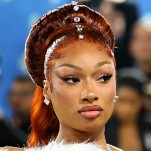Get Pissed: You're Still Paying More Than Men Do for Deodorant
LatestDear Faceless Overcharged Everywoman: Did you know you are still paying as much as 30 cents more per stick of deodorant than a man “version” for no good reason, when, if anything, a dude’s deodorant needs more of the anti-pit stink stuff in it? Seems fair, huh? And don’t get me started on what you’re squandering on dry cleaning!
It’s an issue that’s as old as the day is long — women pay more money than men for certain goods and services and it don’t make no sense. Anecdotally, you realize this when you go for a smart new haircut and notice that men’s haircuts cost several dollars less even if you literally only need a trim or have a pixie cut.
Or when shopping, you might notice that your shaving cream is substantially pricier, ostensibly because it has some soft-ifying flower-scented gel lady beads in it to erase that irksome natural leg scent of yours. Or when you drop off your dry cleaning and discover that men’s shirts are easily a third cheaper (or more) to spiff up than your own basic “blouses.”
In a recent piece at Vox, we learn that, FYI, nothing much has changed since that infuriating update at Marie Claire a few years back:
In the discussion about gender-based pricing, a few sources pop up regularly. In one often-cited 2011 study, researchers at the University of Central Florida found that women pay significantly more for haircuts, dry cleaning, and deodorant than men do. In 2010, Consumer Reports found an array of products, like razors and body spray, that cost more for ladies than men. When the state of California in 1996 outlawed gender pricing, it found that women spent around $1,351 per year more than men due to gender-based pricing at places like dry-cleaners and hair salons.
Vox author Danielle Kurtzleben note that it’s #notallproducts, and that some companies offer men’s and women’s products at the same price (though I can’t tell you what those are and am having trouble finding them). But the real issue is of course WHY IN THE NAME OF ALL THAT IS HOLY ARE WE PUTTING UP WITH THIS SHIT? It seems so clear-cut, as issues go, that it’s wrong. And every time I think about it, I’m infuriated again, and then I just go back to my life and forget about it until another thing reminds me. For some weird reason, I think nothing is to be done. But that is not true. And it’s also lazy.
Kurtzleben explores why this is really happening with the following explanations:
You Don’t Know Any Better
This is probably the biggest culprit, in my opinion. You know, of course, intellectually that gender pricing is real, but when you go shopping and hit the actual pain point, you probably don’t realize it. The very process of shopping for certain grooming aids is segregated by gender, so you’d have to go out of your way to even note the price of Old Spice deodorant compared to your Dove. In fact, the only comparison you’re probably even making is just within a slew of all-overpriced products geared to you by gender. As usual, to do something about this, you’d have to go out of your way to investigate a different section of (cheaper) product, and unless you’re doing so on purpose, this probably won’t happen.
Get Pissed Alert
-

-

-

-

-

-

-

-

-

-

-

-

-

-

-

-

-

-

-

-

-

-

-

-

-

-

-

-

-

-

-

-

-

-

-

-

-

-

-

-








































